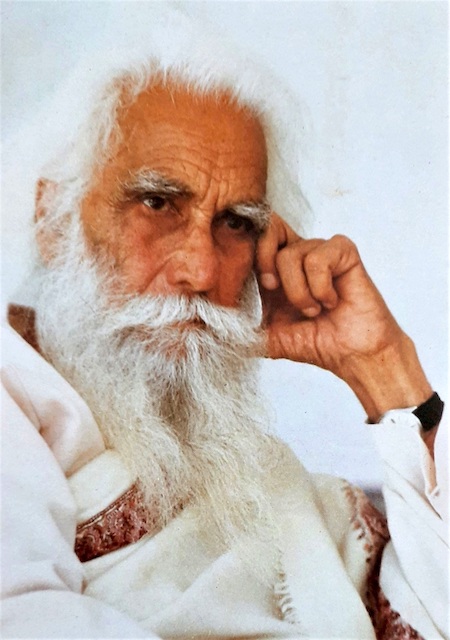
On the 38th anniversary of his passing, we remember Sobha Singh, a revered artist whose brushstrokes captured the essence of Sikh history and Punjabi culture. Born in 1901 in Sri Hargobindpur, Punjab, Sobha Singh’s journey from a young boy with a penchant for drawing to becoming one of India’s most celebrated painters is a testament to his unwavering dedication to art. Known as the ‘Saint Painter,’ Sobha Singh’s works, particularly his iconic portraits of Sikh Gurus and depictions of Punjabi folklore, have left an indelible mark on the world of Indian art. His life and legacy continue to inspire artists and art enthusiasts alike, making this anniversary a fitting occasion to reflect on his contributions to the cultural tapestry of India.
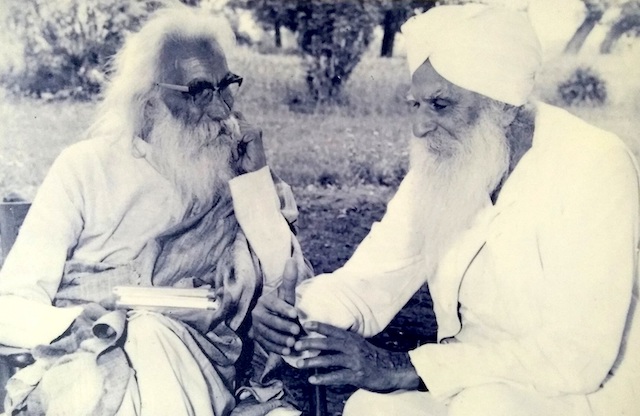
Sobha Singh was born on November 29, 1901, in Sri Hargobindpur in District Gurdaspur, Punjab. His mother, Ichhran Devi, died when he was four. He spent his childhood in his native village, where he learnt to draw and sculpt. His father, Deva Singh, rebuked him for wasting time drawing figures. He did not like his son’s interest in art as he felt all artists remained paupers. Sobha Singh was admitted to an industrial school in Amritsar in 1916, where he did a course in arts and crafts. Later, in 1919, under his father’s influence, he joined the army as a draftsman and served in Baghdad. Sobha Singh returned to India in 1923 and took up painting for a living. In 1926, he went to Lahore and established a film company. He made a film ‘But-Tarash’.

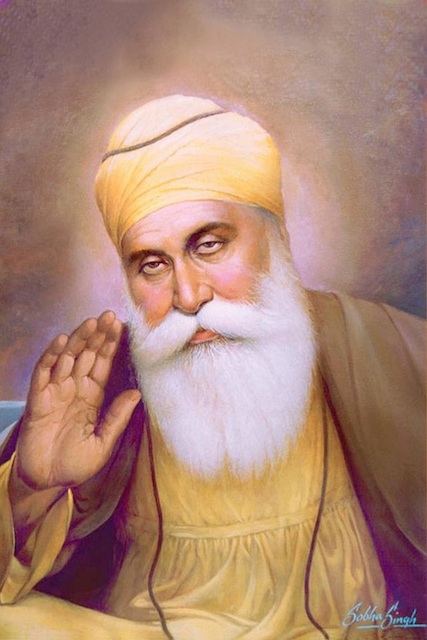
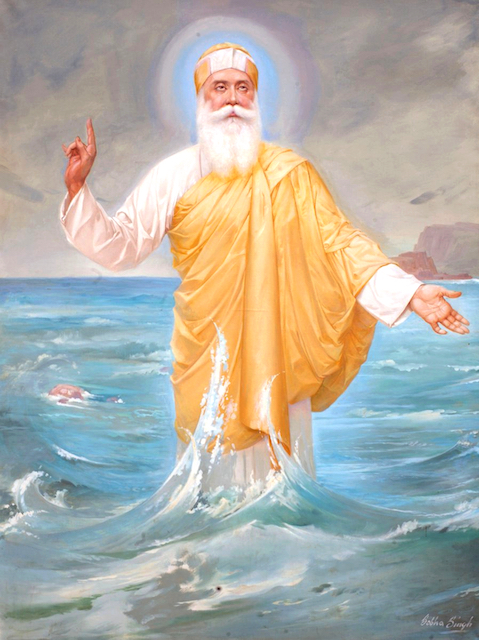
Sobha Singh shifted to Delhi in 1931, where he succeeded and drew posters for Indian Railways and the Post and Telegraph Department. His patron was Colonel GD Tata, who appreciated his work and encouraged him. Gurbax Singh, a noted Punjabi writer, founded Preet Nagar, a colony of idealists, midway between Lahore and Amritsar. Famous writers, artists and educationists gathered from all over to settle there. On Gurbax Singh’s invitation, Sobha Singh came to live there in 1942 for a brief period. Nanak Singh, a reputed novelist, and Balwant Gargi, a well-known essayist and playwright, were companions. Sobha Singh migrated to Andretta, a small village in the Kangra Valley, in 1947 and built a small house there. According to him, there is peace in the mountains. The mind becomes vacant, and a sort of bliss comes over it. In 1967, Chandigarh’s first Chief Commissioner, Dr M S Randhawa, offered him a residential plot, but Sobha Singh declined the offer saying that Andretta had been beautiful and peaceful.

His wife, Inder Kaur, died in 1967. He spent the last 39 years at Andretta and was looked after by his adopted daughter Gursharan and her husband. Sobha Singh followed a strict daily routine. To quote him, “I got up at three in the morning. At that time, one can be with oneself. I read until it becomes light. I am especially fond of Emerson, Krishnamurthi and Khalil-Gibran. Then I walk alone or with my daughter if she is awake. After a breakfast of fruits, I go to my easel. I do all work that requires concentration in the morning.” He worked for nearly 12 hours a day, even in his 84th year. To him, the secret of his longevity was hard work.
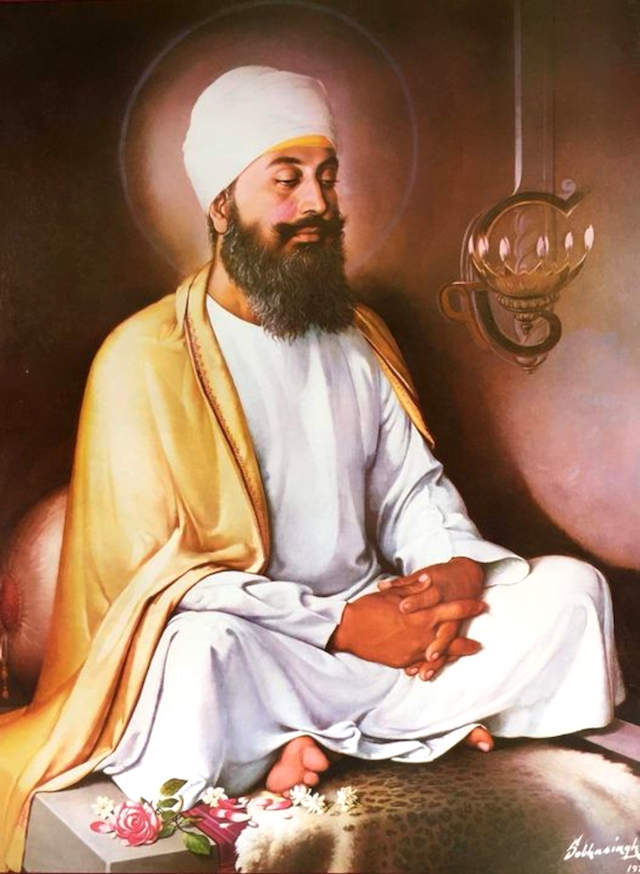
Sobha Singh was not in favour of painting human misery and suffering. He felt that an artist should paint only beautiful things even at the risk of rejection. Talking about human misery and suffering, he emphasized, “It is already there, almost everywhere…. Is there any need to paint it on paper? I only want to paint beauty and goodness in life, which are getting rarer, day by day. The concept of Satyam, Shivam and Sundaram (Truth, Goodness and Beauty) with me is Sundram, Shivam and Satyam.” His medium was an oil painting on canvas, but he also achieved the delicacy and lyricism of the Kangra miniature.
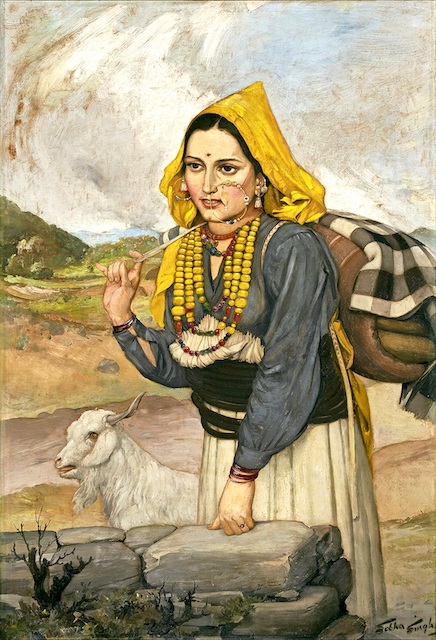
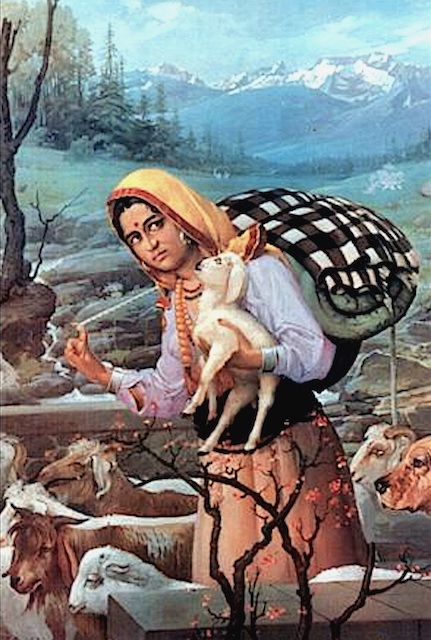

To him, all religions are equal. Most of his paintings are on Sikhism; the struggle of Sikhs against Mughal Emperors never appeared in any of his paintings because he was a lover of peace, harmony, and human brotherhood. He explained, “The paintings of wars and religious intolerance widen the gulf among men. But the paintings of the martyrs of peace cover up the cleavages among human beings. Such a painting is comparable to a lighted candle which sends its glow to a limited area, but its reality becomes very significant.”
His Art Gallery at Andretta is a treasury of his works. Portraits of Sikh Gurus, Christ, Krishna, and Sheikh Farid embellished the walls of the Gallery.
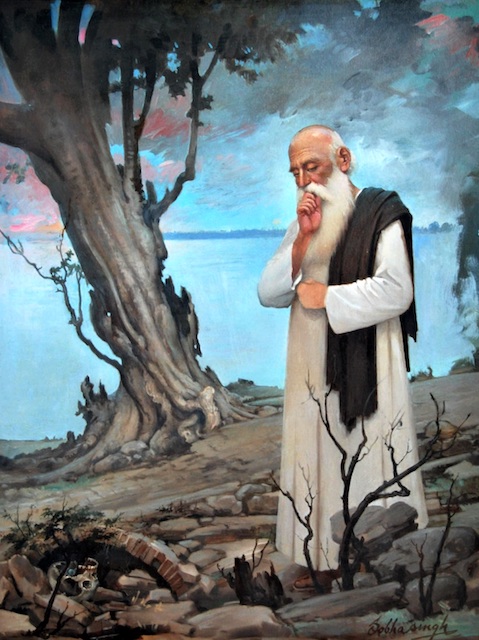
His earliest painting of Guru Nanak as a Child was painted in 1934. Influenced by the Christian Art of the Middle Ages, it depicts Child Nanak on his mother’s lap, Tripta. The background shows Shiva, Saraswati, Sita and Rama showering flowers on the holy child from the heavens. In 1937, he drew another painting on Guru Nanak, entitled, ‘Nam Khumari Nanaka, Charhi Rahe Din Raat’. The Guru is shown in meditation with his eyes half-closed. His paintings of Guru Nanak reached many museums, libraries, and Sikh homes and are revered. Sobha Singh painted Guru Har Krishan Healing the Sick for Bangla Sahib Gurdwara of Delhi. In his paintings of Guru Gobind Singh, Sobha Singh endeavoured to capture the determination of the Guru, which was a symbol of defiance of tyranny.
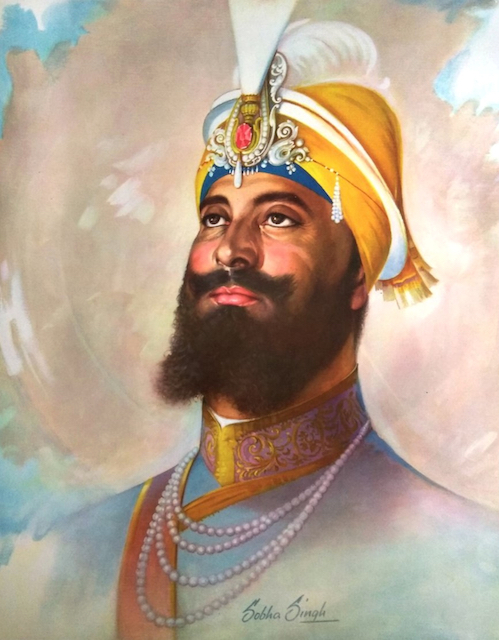
He painted a portrait of Ravi Das in which he showed the Guru repairing the shoes. There is an interesting story behind his painting. The client has wanted Sobha Singh to paint the Guru in meditation resting against a bolster in a glorified manner. Sobha Singh insisted, “His (Ravi Das) glory consisted in the enormous spiritual stature he attained despite his social status.” This could be expressed best by showing the Guru at his trade of cobbler.

Inspired by the romantic legends of Punjab, he painted Sassi-Punnu in 1929. Sassi is depicted as a charming girl lost in dunes running in search of her lover, forcibly carried away. In 1944, he painted his masterpiece ‘Sohni Mahiwal’. He captured in this painting the speechless anguish of two young hearts. The lithe figure of Sohni with a wet dupatta clinging to her torso reveals the physical charm of feminine beauty. His painting ‘Sohni Back to Heaven’ is an excellent work. ‘Her Last Desire’ was the title of a painting of Shah Jahan and Mumtaz.
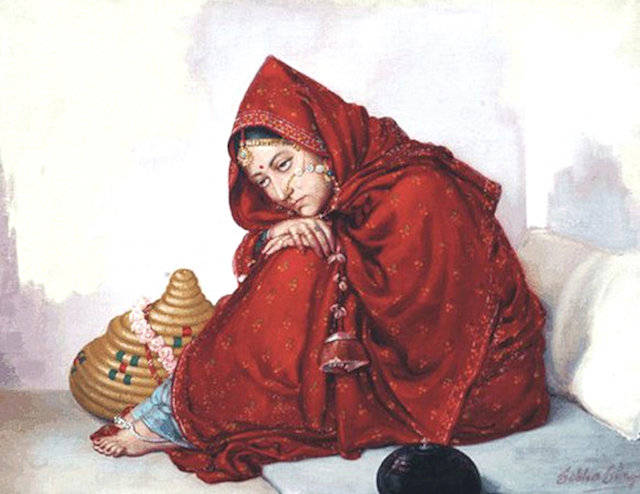
He painted an innocent and shy Kangra bride, sitting on the floor with two baskets on her right side. In another charming painting, a young girl sitting in a palanquin with a cuckoo in front reflects the Kangra culture. Sobha Singh took inspiration from the painting of Kangra school for such works.
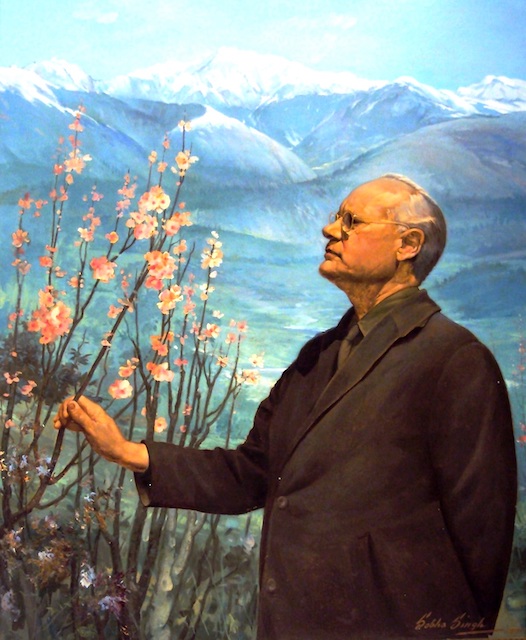
In 1948, he painted a portrait of Mahatma Gandhi for the Public Relations Department of Punjab. The Mahatma is depicted wrapped in a spotless white dress. He has painted portraits of former Chief Minister of Punjab, Partap Singh Kairon, Dr MS Randhawa, Sant Harchand Singh Longowal and Rajiv Gandhi.

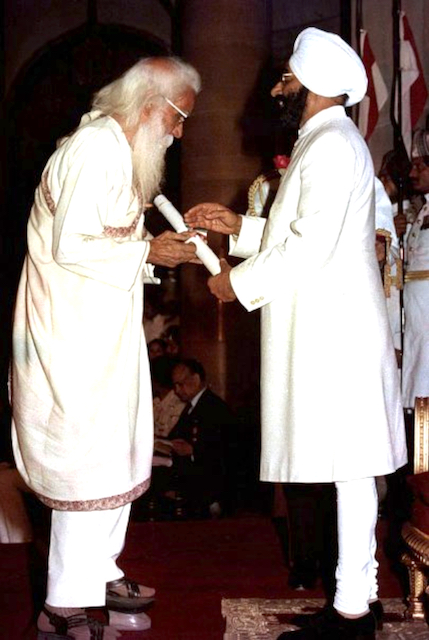
Sobha Singh received many awards. Punjabi University, Patiala, conferred a Fellowship on him in 1970. The Ministry of Information & Broadcasting of the Union Government made a documentary on him in 1973. He was declared a State Artist in 1974 by the Punjab Government. In the same year, he was honoured by the Guru Nanak Dev University, Amritsar. The Punjab Arts Council gave him its highest award in 1982. He was conferred with Padma Shree– the fourth-highest civilian award by the Government of India in 1983. Besides, he was a member of the Punjab Lalit Kala Akademi. After his death, The Shiromani Gurdwara Parbandhak Committee decided to display his portrait in the Sikh Museum in the Golden Temple Complex. Guru Nanak Dev University has published a book, ‘Painter of the Divine’, based on his life and works.
A staunch supporter of national integration, Sobha Singh was a celebrated artist, philosopher, scholar, lively humorist, and exciting conversationist. He breathed his last on August 22, 1986, at PGI, Chandigarh, where he was admitted at the instance of the Punjab Chief Minister.
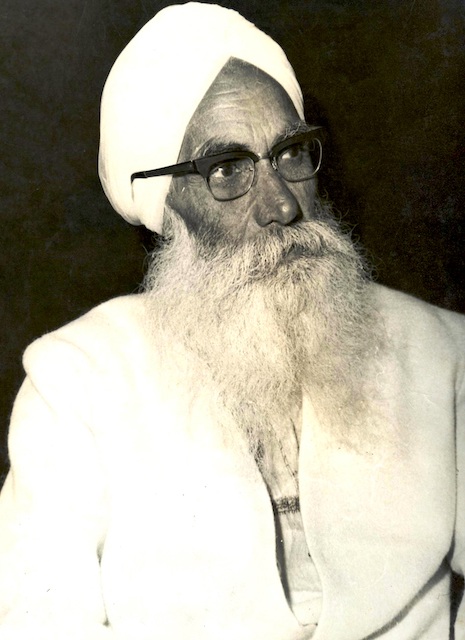
As we commemorate the 38th anniversary of Sobha Singh’s passing, we are reminded of the profound impact he had on Indian art and culture. His legacy extends far beyond the canvases he adorned with vibrant colours and soulful portraits. Sobha Singh was more than an artist; he was a visionary who used his talent to bridge divides, celebrate shared heritage, and inspire generations. His unwavering commitment to depicting beauty and goodness in a world often marred by conflict serves as a timeless lesson in the power of art to elevate the human spirit. The serenity of Andretta, where he chose to spend his final years, is reflected in the tranquil beauty of his works. Today, as his paintings continue to grace homes, institutions, and places of worship, they stand as a testament to his enduring vision of “Satyam, Shivam, Sundaram” – Truth, Goodness, and Beauty. Sobha Singh may have left this world, but his art continues to speak to us, reminding us of the rich cultural tapestry of India and the timeless values that bind us together. In remembering Sobha Singh, we celebrate not just an artist, but a cultural icon whose brush strokes painted a legacy that will inspire for generations to come.
********
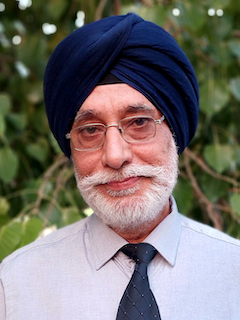
Sarbjit Bahga (b1957) is a Chandigarh-based architect, author, photo artist, and archivist. He is the Principal Architect of Bahga Design Studio LLP. Earlier, Bahga worked in the Department of Architecture, Punjab, Punjab Health Systems Corporation, and Punjab Mandi Board in various positions.
He has more than 42 years of practical experience designing various types of buildings, complexes, and large campuses. His completed works include an eclectic range of administrative, recreational, educational, medical, residential, commercial, and agricultural buildings. A monograph on his selected works titled “MODERN REGIONALISM: The Architecture of Sarbjit Bahga” has been published.
Bahga is also a keen researcher and a prolific architectural writer. He has 12 books to his credit, which include Modern Architecture in India, New Indian Homes, Le Corbusier, and Pierre Jeanneret: The Indian Architecture, Trees in Urban Habitat, Landscaping Human Habitat, New Indian Architecture -1947-2020, and Hand-Drawn Perspectives and Sketches. Bahga’s contribution to architecture has been largely recognized. He is a three-time recipient of the World Architecture Community Awards. His name has been featured in the Guinness Book of World Records for designing the “longest covered concrete corridor” in Vidya Sagar Institute of Mental Health, Amritsar.



